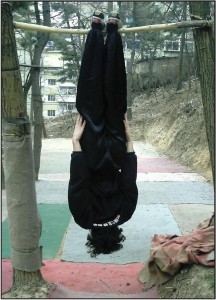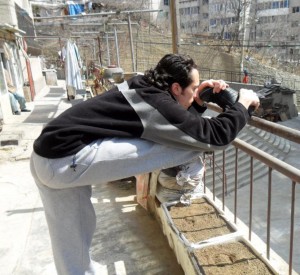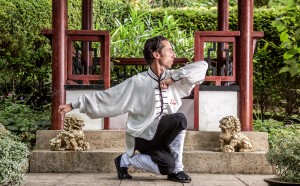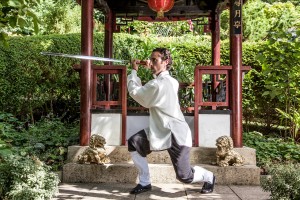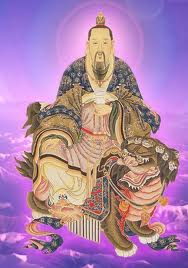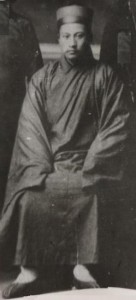This is a complete and unique style of Chinese Kung Fu / Martial Arts. It contains both long and short range techniques and is comprised of:
- Punching
- Kicking
- Locking
- Throwing
- Acupuncture point striking
It is taught in the traditional step by step approach incorporating all aspects of Seven Stars Praying Mantis. It is ideal for those wanting to study a traditional Chinese martial art, the traditional way.
Basic Training
Students commence with learning exercises which increase the flexibility of the waist, followed by leg exercises. The first part of which is stretching the legs. Through continuous practice the flexibility and elasticity of tendons and muscles is increased, which enhances the range of movement in the joints. This in turn improves the speed of techniques. The increased flexibility also makes injuries less likely to occur during training.
The second stage involves practicing the Tuifa or ‘Kicking techniques’. Students learn the unique kicks of Seven Stars Praying Mantis including the ‘24 deadly continuous mandarin duck kicks’ and ‘36 hidden kicks’. Some of the kicks taught are: Tantui (Spring kick), Shizi tui (10 character kick), Gua tui (Hanging kick), Furen jiao (Axe blade kick), Yuanyang jiao (Mandarin ducks kick) etc. By practicing the many different kicking techniques overall co-ordination, flexibility, power and control of the legs increase. The student is also introduced to how the kicks are applied in a combat setting.
After being introduced to the above waist and leg exercises students should commence learning Zhuanggong (Stake exercises) also known as Zhanzhuangfa or ‘The method of standing like a wooden stake’. This involves learning and perfecting the basic stances. Standing still in these various postures for prolonged periods helps cultivate our Qi or ‘energy’. It increases the muscular power of the legs, developing deep roots, providing the student with a strong foundation upon which the rest of the style can be built. Today, due to the hardship experienced in learning such an exercise it has become relatively unknown within Seven Stars Praying Mantis circles.
Forms Training
Includes:
- Hand forms
- Two person hand forms
Forms or sets as they are sometimes known are a series of techniques linked fluidly together. They incorporate the many aspects of this martial art and develop and improve co-ordination, balance, stamina, strength, speed and focus. Through learning the forms or sets you are actually learning how to fight as each and every technique of Seven Stars Praying Mantis has numerous fighting applications. The forms are divided into three main categories namely:
- Forms which emphasize rigidness
- Forms which emphasize flexibility
- Forms which emphasize both
Every form teaches the student a different strategy of attack or defence depending upon the opponent. For example, against a larger or stronger opponent we use flexible techniques as opposed to using force against force. Whilst against a smaller or weaker opponent we can employ more aggressive and direct attacks. Through practicing the systems many forms, a student learns the different theories of the style leading to a well-rounded martial artist.
Click here for Kui De Tang Seven Stars Praying Mantis Traditional Single & Two Person Form Curriculum Taught by James Rodriguez
Weapons
Weapon forms introduce students to the various weapons found in Seven Stars Praying Mantis. Weapons act as an extension of ourselves and therefore increase our range. Weapons develop strength, focus and co-ordination. Before starting to practice weaponry the student must possess a good standard of jibengong or ‘basic training’. Each form has techniques that are unique to that particular weapon. This increases the student’s knowledge of the way it was meant to be used. As the student progresses the complexity of the weapons and their forms increase. There are also a numerous amount of two person weapons forms. Combined, these single person and partner forms along with Da gan (long pole) and Da qiang (long spear) training provide the basis of all weapon fighting skills and techniques.
In Chinese martial arts weaponry is divided into four categories:
- Long weapons – stick, staff, spear, awl, pike, long spear etc.
- Short weapons – short stick, broadsword, straight sword etc.
- Flexible weapons – sweepers, two-sectional staff etc.
- Twin weapons – which are used in pairs i.e. double hooks.
Later, two-person weapon sparring forms are also taught.
Mantis Hard Qigong
Qigong is a type of Chinese internal exercise, an energetic and physical practice which pays great importance to correct posture and breath control. Its movements are simple making it suitable for anyone to learn weather in good health, rehabilitation or by those carrying injuries to their lower body. Qigong is used as a means of physical exercise as well as in the prevention and treatment of diseases.
Benefits of Qigong:
- Increases strength & flexibility
- Heals injuries & regenerates damaged tissue
- Improves circulation & vascular function
- Increases bone density
- Increases energy levels
- Improves concentration
- Improves stamina, balance & athletic performance.
Yangsheng Exercises
Taoist Yangsheng Gong (Health Preservation Exercises) the exercises are performed for health preservation, disease prevention and treatment. They work by using self-massage techniques which stimulate the natural healing powers of the body, preventing disease from taking hold. The exercises are performed daily either in the morning or evening. All of these exercises may be performed from a seated position making them particularly suitable for the elderly or chronically ill.
Dao Yin (Guiding & Stretching) a simple sequence of stretches which are performed softly and slowly. The various postures help to establish the inner circulation of Qi around the various channels, by gently releasing blockages that inhibits its flow and thus our flexibility. They pay attention to breath control and can also contain self-massage techniques. All of these exercises may be performed from a seated position:
Benefits of Yangsheng Gong & Dao Yin:
- Increases strength/flexibility of muscles & joints
- Help in the treatment of various conditions from back pain to heart disease
- Speeds up rehabilitation process
- Improves circulation
- Increases bone density
- Increases stamina
- Stress relief
- Improves muscle tone
- Relieves muscular tension
- Promotes longevity and good health.
Taoist Meditation
Taoist Meditation or ‘Jingzuo’ (Quiet Sitting) may be performed sitting, lying or standing. It is performed silently with the eyes slightly open gazing at the tip of the nose with the tip of the tongue in contact with the upper palate and the mind concentrated on the Dantian (lower abdomen).
Benefits of Meditation:
- Reduces hypertension (high blood pressure)
- Decreases heart rate
- Relieves anxiety and other chronic conditions caused by stress
- Relieves muscular tension
- Improves digestion
- Inner silence
- Promotes longevity and good health.
Free-Sparring
Includes:
- Free-Sparring without weapons
- Free-Sparring with weapons
Having covered some of the previous stages, students who wish to learn Praying Mantis free-sparring begin with learning various two person exercises. Although students often do not realize it at the time these drills are the first step in learning Praying Mantis free-sparring. Later, students may also go on to learn free-sparring with weapons.
